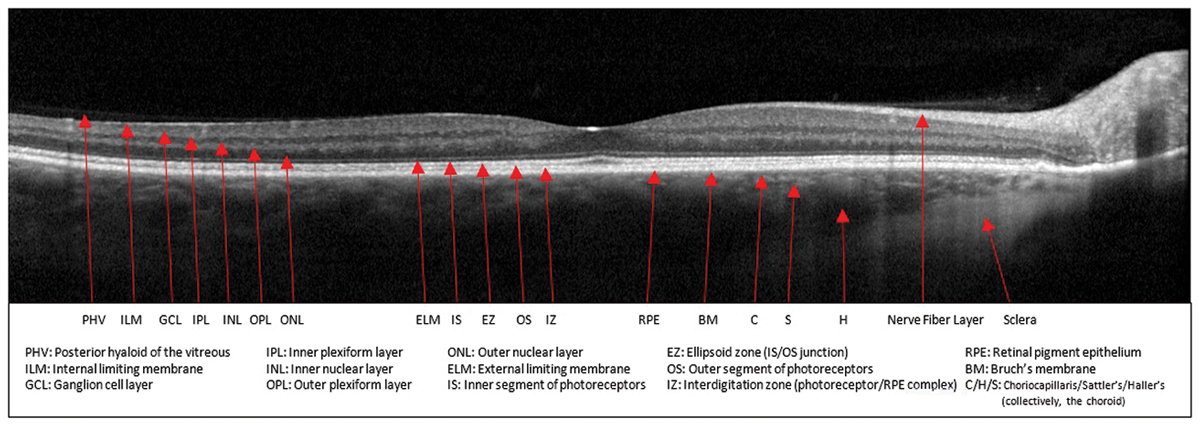 |
Monitoring the foveal ONL thickness during early anti-VEGF treatment can give information about the visual outcomes in type 1 CNV. Photo: Sara Weidmayer, OD. Click image to enlarge. |
There is little known about the characteristics of the outer nuclear layer (ONL) during treatment of neovascular age-related macular degeneration (nAMD) and choroidal neovascularization (CNV). Therefore, in a recent study, researchers investigated whether ONL thickness can indicate photoreceptor function and visual prognosis when treating nAMD with an anti-VEGF agent.
A total of 94 type 1 CNV eyes were compared with 35 control eyes. Along with best-corrected visual acuity (BCVA), the location of CNV, foveal ONL thickness and subretinal fluid height were measured using OCT and analyzed over one year.
Patients with type 1 CNV had a thinner foveal ONL thickness compared with controls. The reduced foveal ONL thickness partially recovered with anti-VEGF treatment, with a corresponding improvement in BCVA. An increased ONL thickness after the three initial loading doses of aflibercept was related to a good visual outcome in type 1 CNV associated with nAMD.
Wet AMD eyes also showed more ONL thinning and decreased visual acuity on baseline testing compared with controls. “Interestingly, during the initial loading doses, the foveal ONL thickness recovered partially as vision improved simultaneously,” the authors explained in their paper on the research for Scientific Reports. “This phenomenon can be explained by the hypothesis of ‘a point of no return.’ Photoreceptor cell bodies that have degenerated and crossed the point of no return are unable to recover their functional capabilities despite treatment. However, cell bodies with decreased function that have not yet reached the apoptosis stage could be salvaged.”
Therefore, the authors suggest, the amount of salvageable photoreceptor cell bodies should be considered as a prognostic factor for good visual outcome.
“By measuring the amount of ONL that was restored, we assumed that the eyes with ONL improvement had more photoreceptor cell bodies that could be salvaged after the loading doses were administered compared with the eyes without ONL improvement,” they explained. “As a result, ONL thickness after three monthly loading doses and the change in the ONL thickness during the loading doses had a significant positive correlation with the one-year visual outcome.”
The question is then: why do certain eyes have many salvageable photoreceptors and good visual prognosis? Previous studies have demonstrated that poor visual prognosis is associated with the presence of subfoveal vascularized pigment epithelial detachment in nAMD or in central serous chorioretinopathy. In this study, group A had more eyes with subfoveal CNV than group B. Because only type 1 CNV cases were included, direct infiltration stretching from CNV into the retinal tissue was minimal.
“Even if CNV did not penetrate the retinal pigment epithelial tight junction barrier, it could still harm the photoreceptor vitality and vitiate vision when it lay subfoveally,” the authors noted.
“In summary, the foveal ONL thickness may indicate foveal photoreceptor vitality,” the authors concluded in their paper. “Improvements in ONL thickness during the initial three loading doses with intravitreal anti-VEGF were considered to indicate photoreceptor viability vs. irreversible cell death and, hence, correlated with a good one-year visual prognosis. Early improvement in the foveal ONL thickness with anti-VEGF treatment may be advantageous as a clinical indicator for the remaining healthy photoreceptors and may be a positive prognostic factor for visual acuity in type 1 CNV from nAMD.”
Lee S, Tae Kim K, Yoon Kim D, et al. Outer nuclear layer recovery as a predictor of visual prognosis in type 1 choroidal neovascularization of neovascular age-related macular degeneration. Scientific Reports. March 28, 2023. [Epub ahead of print]. |


